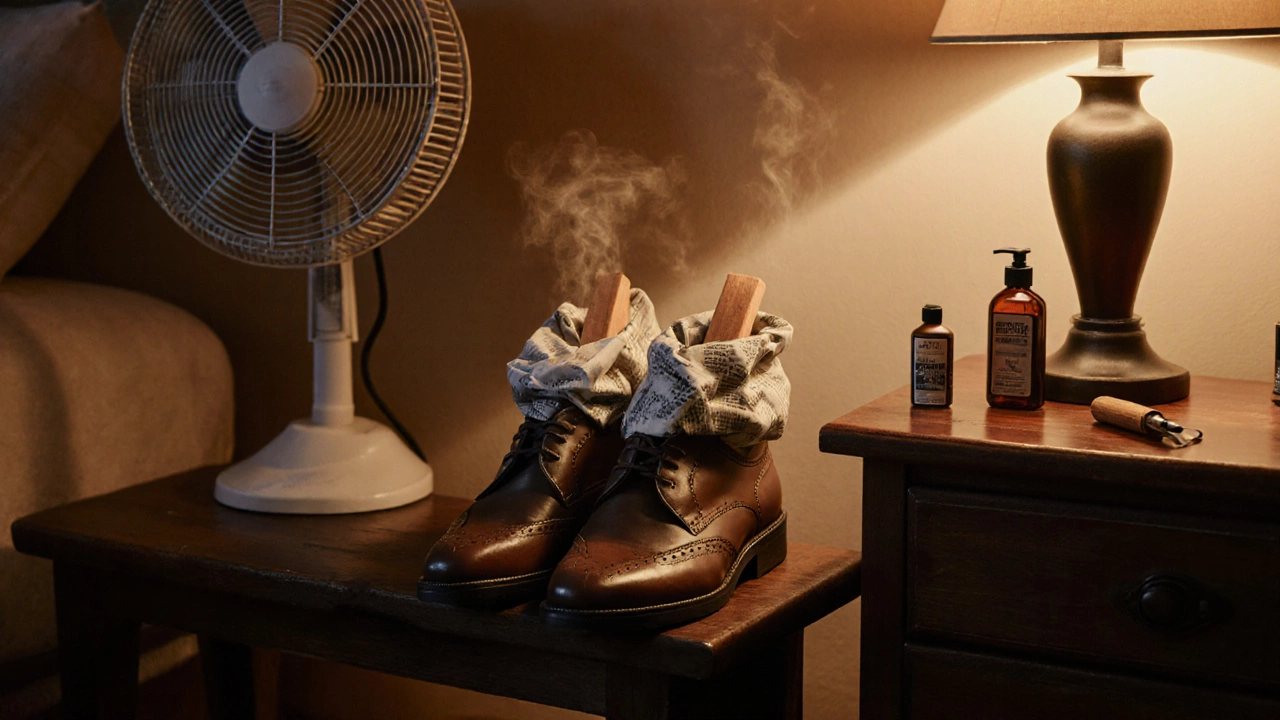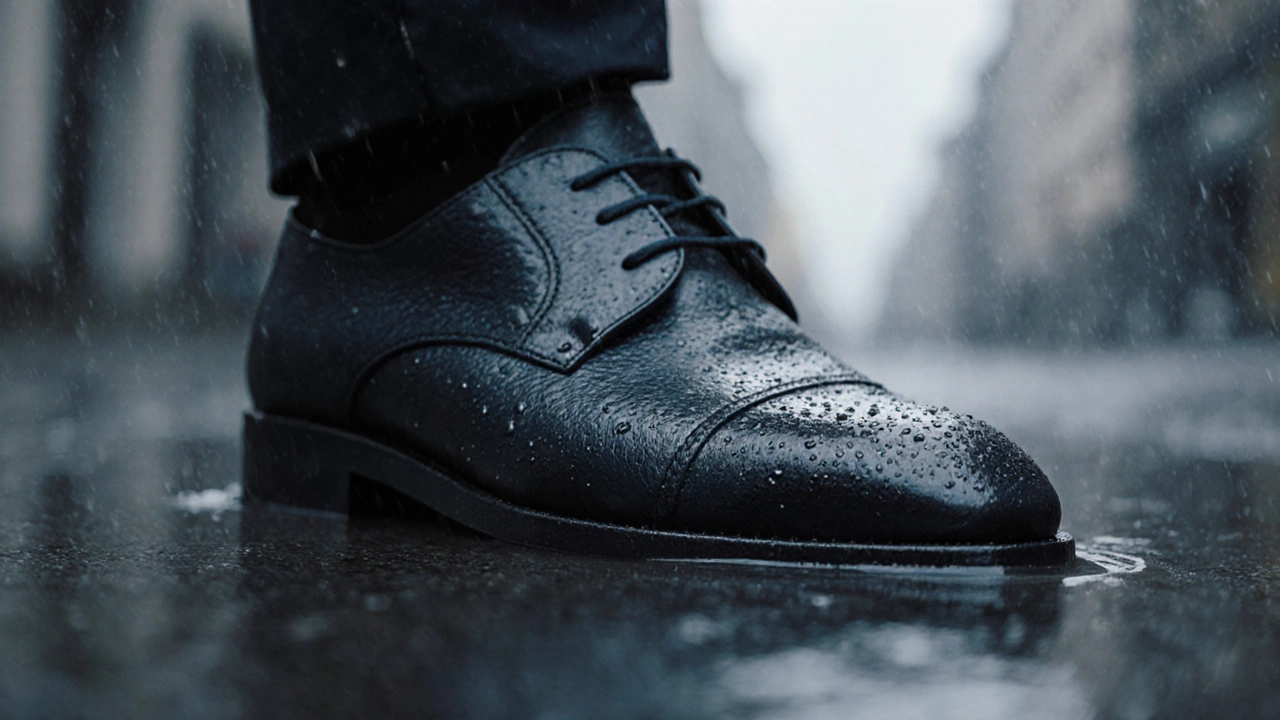Leather Shoe Shrinkage Calculator
Estimate your shoe's potential shrinkage after getting wet. Select material type and drying method for accurate results.
Results
Quick Takeaways
- Wet leather fibers swell, then dry unevenly, which can make shoes feel tighter.
- Full‑grain leather is the most resistant; suede tightens the most.
- Quick drying, proper conditioning, and gentle stretching keep the fit comfortable.
- Avoid direct heat; let shoes air‑dry at room temperature.
- Regular maintenance reduces the risk of permanent shrinkage.
When you step out in a rainstorm, you may notice your favorite leather shoes footwear made from animal hide that has been tanned and finished feel suddenly tighter. That sensation isn’t a myth-wetting leather changes its structure. Understanding why this happens, which leather types react the worst, and what you can do to keep the fit stable will save you from painful blisters and costly replacements.
What Happens Inside Wet Leather?
At the microscopic level, leather is a network of collagen fibers bound together with natural oils and tannins. When water a polar molecule that seeks out spaces within the material penetrates the hide, two things occur:
- The fibers absorb water and swell, expanding the material’s volume.
- As the leather dries, the fibers contract but not uniformly-some areas shrink faster than others, creating tension that pulls the shoe tighter around your foot.
This uneven contraction is why a shoe that felt perfect when dry can suddenly pinch after a puddle splash.
How Different Leather Types React
Not all leather behaves the same way. Below is a quick comparison of common hides and how they handle moisture.
| Leather Type | Water Absorption | Dry‑time (hrs) | Typical Shrinkage |
|---|---|---|---|
| Full‑grain leather | Low (natural oils protect) | 12‑18 | 0‑2% |
| Top‑grain leather | Medium | 10‑15 | 2‑4% |
| Suede | High (open pores) | 8‑12 | 5‑8% |
| Patent leather | Very low (synthetic coating) | 4‑6 | 0‑1% |
Full‑grain leather’s natural oils act like a built‑in waterproofing layer, so it swells the least. Suede, with its brushed nap, soaks up the most water and shrinks dramatically if you let it dry unevenly.
Common Myths About Wet Leather
People often assume that wiping a wet shoe with a towel or putting it in a dryer will speed up drying without side effects. Both actions can trap moisture inside the fibers, causing more distortion. Another myth is that leather will return to its original shape after a few wears. In reality, once the fibers have re‑aligned under tension, the shoe may stay tighter unless you intervene.
Step‑by‑Step: How to Dry Wet Leather Shoes Properly
- Remove excess water. Gently pat the surface with a clean, absorbent cloth. Avoid rubbing, which pushes water deeper.
- Unscrew laces or loosen straps. This opens the interior, letting air circulate.
- Stuff the shoe. Insert newspaper or shoe trees made of cedar. The bulk of the newspaper absorbs lingering moisture while the shoe tree maintains shape.
- Place in a ventilated area. A room at 20‑22°C (68‑72°F) with low humidity is ideal. A fan set on low can improve airflow without blowing directly on the leather.
- Avoid heat sources. Radiators, hair dryers, and direct sunlight can cause the surface to dry too quickly, leading to cracks and more shrinkage.
- Let it dry naturally. Depending on the leather type, expect 12‑24hours for full‑grain and up to 48hours for suede.
When the shoe feels dry to the touch, remove the newspaper and re‑lace. If the fit is still tight, move on to the conditioning step.
Conditioning and Stretching After Wetting
Conditioning restores the oils that evaporated during drying. Choose a product that matches your leather type-e.g., a cream conditioner for full‑grain, a suede‑friendly spray for nub‑type. Apply a thin layer, let it soak for 10‑15minutes, then buff with a soft cloth.
If the shoe remains noticeably tighter, a gentle stretch can help. A leather stretcher a device that applies even pressure to widen the shoe interior works best when the leather is still slightly damp. Insert the stretcher, turn the knob a few turns, and leave it in place for several hours or overnight. The combination of moisture, pressure, and conditioning encourages the fibers to relax back into a comfortable shape.

Preventive Care: Keep Wet Leather From Getting Tight
Regular maintenance is the cheapest way to avoid a tight fit after rain:
- Water‑proofing sprays. Look for breathable, silicone‑based formulas. Apply every few weeks, especially before wet seasons.
- Rotate shoes. Giving each pair a rest reduces the buildup of sweat and humidity.
- Store with a shoe tree. Cedar trees absorb moisture and maintain shape year‑round.
- Quick‑dry after exposure. If you notice droplets, follow the drying steps immediately-don’t wait for the shoe to air out on its own.
Even the most careful owners can’t control sudden downpours, but a well‑conditioned pair of leather shoes will flex rather than shrink.
When to Seek Professional Help
If after conditioning and stretching the shoe still feels uncomfortably tight, a cobbler can re‑shape the last (the mold used to form the shoe). Professionals have steam boxes and specialized stretchers that can safely expand the leather without damaging the finish. This service is worth the cost for high‑quality shoes you intend to keep for years.
Frequently Asked Questions
Will all leather shrink the same amount when it gets wet?
No. Full‑grain leather shrinks the least because its natural oils repel water. Suede absorbs the most and can shrink up to 8% if not dried properly.
Can I use a hair dryer to speed up drying?
Avoid direct heat. A hair dryer can dry the surface too quickly, leaving the interior damp and causing uneven shrinkage or cracks.
Is it safe to put leather shoes in the washing machine?
Never. Machine washing saturates the leather, forces it to expand, and then contracts it dramatically, often ruining the shape and finish.
How often should I apply a waterproofing spray?
Apply every 2‑3months, or after heavy rain exposure. Re‑apply more frequently in humid climates.
What’s the best way to store leather shoes during the off‑season?
Store them in a cool, dry place with cedar shoe trees. Avoid plastic bags, which trap moisture and encourage mold.
